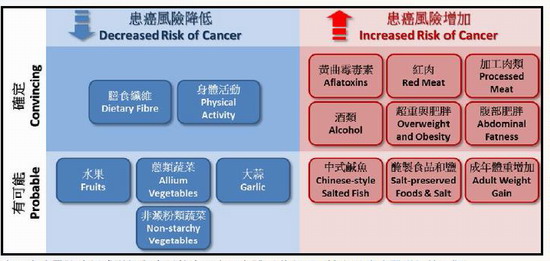
Food Safety Focus (114th Issue, January 2016) – Food Safety Platform
Group 1 Carcinogens in Food – Is Consuming Processed Meat as Dangerous as Smoking?!
Mr. Arthur YAU, Scientific Officer,
Risk Assessment Section,
Centre for Food Safety
In October 2015, when the International Agency for Research on Cancer (IARC) classified processed meat as "Group 1" carcinogen (i.e. carcinogenic to humans), many people misunderstood that processed meat may cause as much harm as other IARC group 1 carcinogens like smoking, asbestos, aflatoxins, etc. Members of the public are concerned that processed meat might be a major risk factor like tobacco smoking in causing cancers.
What is IARC?
Established in 1965, the IARC is the agency of the World Health Organization for promotion of international collaboration in cancer research. It aims to find preventive measures and to reduce the burden and sufferings from cancer. The IARC also aims to coordinate cancer research that cannot be easily studied within national borders, support global cancer policy development and act as a source of authoritative information etc.
IARC Evaluations
The IARC regularly selects agents based on the evidence for human exposure and evidence or suspicion of carcinogenicity for evaluation. Carcinogenicity refers to the ability or tendency to produce cancer. These agents include chemicals, complex mixtures, biological agents and lifestyle factors that some of which may be directly or indirectly related to our diets. As evaluation of the carcinogenicity of substances involves complicated processes including animal and human studies, cancer mechanisms and exposure etc. and complex scientific judgement on the findings, the work is often coordinated by esteemed cancer research organisations like IARC. When evaluating the carcinogenicity of substances to humans, the IARC considers the body of evidence as a whole in order to reach an overall evaluation.
IARC Grouping
The IARC classifies the substances it has evaluated into various groups according to the overall strength of evidence based on cancer hazard (i.e. the potential for the exposure to cause cancer) derived from studies in humans and in experimental animals and other relevant data. As the classification is based on the strength of evidence, it does not mean that substances in the same group carry same level of risk to health as the magnitude of risk (i.e. how likely the cancer will occur) differs greatly. Therefore, comparing the carcinogenic risk of different agents on the same classification (tobacco smoking, aflatoxins, asbestos, alcoholic beverages, processed meat are examples of Group 1 carcinogens) is misleading as they are not equally dangerous. For example, smoking about a packet (15 – 24 pieces) of cigarette each day will lead to 117% excess mortality over lifelong nonsmokers when they reach 60 years of age, whereas consuming every 50g of processed meat daily will increase the risk of colorectal cancer by 18%. The details of the classifications are as follows:
- Group 1: Carcinogenic to humans
- Sufficient evidence in humans
- E.g.: aflatoxins , alcoholic beverages, B[a]P , cadmium , Chinese-style salted fish , chromium (VI) compounds , dioxins and dioxins-like PCBs , and processed meat .
- Group 2A: Probably carcinogenic to humans
- Evidence is limited in humans but sufficient in experimental animals
- E.g.: acrylamide , inorganic lead compound, and red meat .
- Group 2B: Possibly carcinogenic to humans
- Evidence is limited in humans and is less than sufficient in experimental animals; or evidence is inadequate in humans but is sufficient in experimental animals
- E.g. aflatoxin M 1 , bracken fern , and lead.
- Group 3: Not classifiable as to its carcinogenicity to humans
- Evidence is inadequate in humans and is inadequate or limited in animals
- E.g.: melamine, patulin, and sulphur dioxide.
- Group 4: Probably not carcinogenic to humans

Table: Many diet and physical activity related factors are known to contribute to an increase or decrease in cancer risk. (Adapted from the Cancer Atlas, 2 nd edition )
Carcinogens in the Diet
A number of factors, including diet, body weight and physical activities (see Table), can affect the risk of various types of cancer. It is obvious that maintaining a balanced diet (with adequate intake of dietary fibres, fruits and vegetables) and maintaining an active lifestyle can help to reduce the risk for a range of food-related cancers. On the other hand, reduction in the consumption of processed meats, red meat, Chinese-style salted fish, and alcoholic drinks, prevent obesity, and avoid intake of aflatoxins, etc. can contribute to cancer risk reduction.
In the next issue, we will focus on various diet-related cancers.


